Empowering nurses and supporting patients with smart, connected hospital stretchers
22-Oct-2025

2-minute read
Driving safety and efficiency across the care journey
Nurses today are stretched thin—caring for more patients with fewer resources while managing the intense physical and mental challenges of caregiving. These pressures are contributing to rising burnout rates across the profession.1 More than 90% of U.S. EDs report feeling stressed beyond the breaking point, at least some of the time.2 In high-stakes care environments, nurses need solutions that help reduce physical strain, support safety and increase efficiency.
That’s why we designed the Prime Series hospital stretchers. Built to ease the demands of patient handling and reduce the cognitive load of monitoring safety risks like falls, Prime Series Stretchers help teams move patients confidently while supporting both staff and patient safety across the care journey.
The Prime difference
The difference is in the design. Prime Series Stretchers offer features that intentionally address the challenges of modern caregiving:
- Advanced mobility: Options like Big Wheel Advanced Mobility technology and Zoom Motorized Drive enable smoother transport of patients of varying sizes across different surfaces and inclines, supporting staff back health and transport efficiency.
- Connectivity and bed exit alarms: Patient falls are the most common preventable adverse events in hospitals.3 Prime Connect integrates with hospital networks to connect seamlessly to the Vision clinical dashboard, helping monitor fall-risk patients in near real-time. Built-in audio and visual bed exit alarms can also notify staff when patients attempt to exit the stretcher, which has been shown to reduce fall-related incidents in high-risk areas such as emergency departments.4
- Electric functionality: Features such as the electric-powered lift pedal and BackSmart Lift Assist allow clinicians to reposition patients and maneuver around the stretcher without manual lifting, helping reduce the risk of injury for staff while enhancing support for patients. Patients can also adjust their positioning for greater comfort and control.
- Support surfaces: Our IsoFlex SE, ComfortGel SE and Ultra Comfort SE support surfaces are specially designed for Prime Stretchers, each featuring gel technology to help prevent pressure injuries—a hospital-acquired infection affecting approximately 2.5 million people in the U.S. annually.5
From Prime Connect’s monitoring capabilities to the mobility features of Fifth Wheel, Big Wheel and Zoom, Prime Series Stretchers offer configurable options to meet your team’s unique needs, driving better outcomes for patients, staff and facilities.
Related
Prime Series
Our Prime Series stretchers are designed to reduce physical strain on clinicians, enhance comfort during patient transport and drive hospital efficiency. Fully equipped and highly configurable, our Prime Series stretchers allow you to create a solution that meets your specific needs.
Learn moreHow smart stretchers support hospital fall prevention protocols
Explore the ways smart, connected stretchers can support fall prevention protocols and lighten the load for care teams. Download the executive brief.
Learn moreFall Prevention Solutions
Stryker’s connected ProCuity beds and Prime Connect stretchers can help with your hospital's fall prevention strategies.
Learn moreStrategies for Reducing Falls in the ED
In this educational webinar we will share eye-opening statistics, discuss human and financial costs of falls, identify risk factors and interventions, and focus on evidence-based practices in the utilization of technology for prevention of patient falls.
Learn more1. Shah MK, Gandrakota N, Cimiotti JP, et al. Prevalence of and factors associated with nurse burnout in the US. JAMA Network Open. 2021;4(2):e2036469.
2. Kelen GD, Wolfe R, D’Onofrio G, et al. Emergency Department Crowding: The Canary in the Health Care System. NEJM Catalyst. 2021;2(5).
3. Dykes, P. C., Curtin-Bowen, M., Lipsitz, S., et al. Cost of Inpatient Falls and Cost-Benefit Analysis of Implementation of an Evidence-Based Fall Prevention Program. JAMA Health Forum. 2023; 4(1):e225125.
4. Stryker. 2020. Quality Improvement Initiative Results in Successful No Falls Challenge in a Busy Emergency Department. Mkt Lit-1906.
5. Agency for Healthcare Research and Quality http://www.ahrq.gov/professionals/systems/hospital/pressureulcertoolkit/putool5.html Last accessed September 17, 2025.
AC-GSNPS-COMM-2229701_REV-0_en_us




